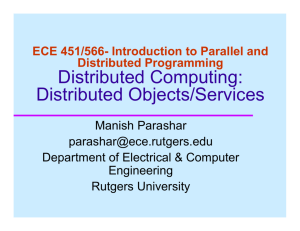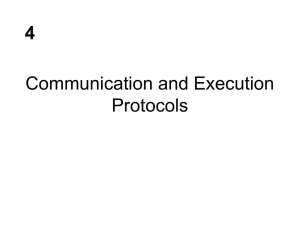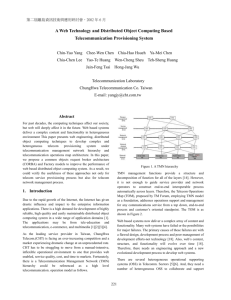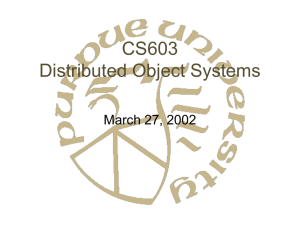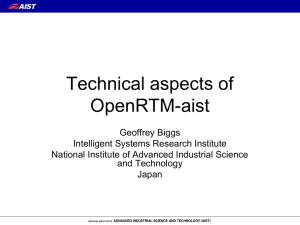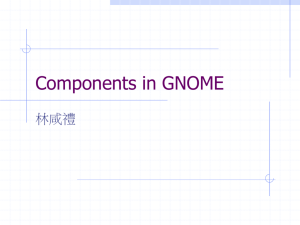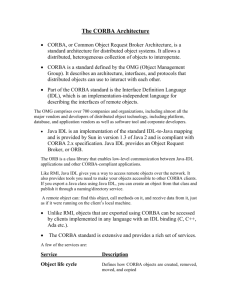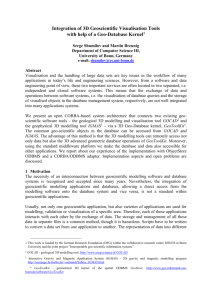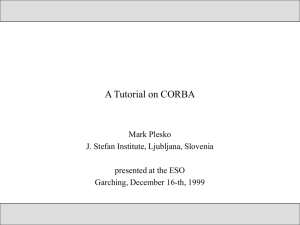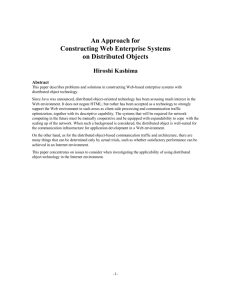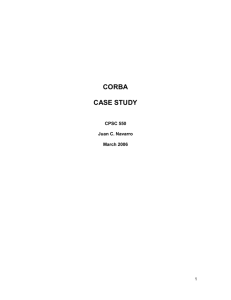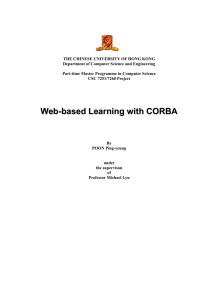IT-601 Distributed System
advertisement
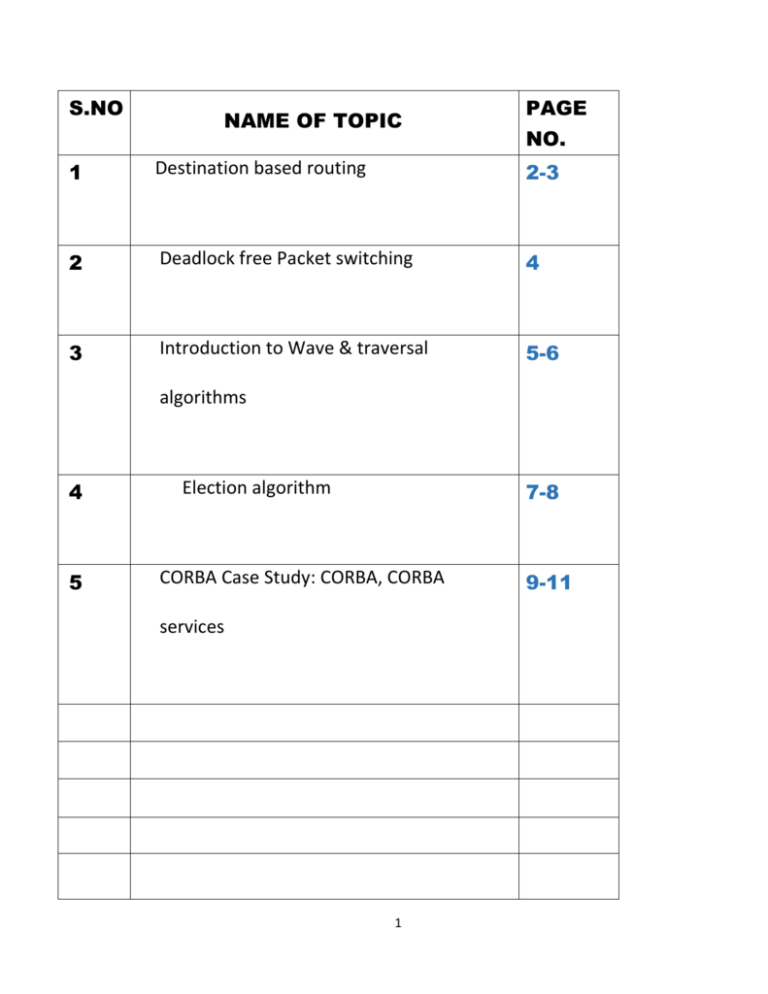
S.NO NAME OF TOPIC PAGE NO. 1 Destination based routing 2-3 2 Deadlock free Packet switching 4 3 Introduction to Wave & traversal 5-6 algorithms 4 5 7-8 Election algorithm CORBA Case Study: CORBA, CORBA services 1 9-11 UNIT-5 Destination Based Routing Destination-based routing builds the "route" from the destination backwards to the source. Destination-based routing is the typical, most common type of routing.For this, each message that we send contains the address of the destination and the forwarding decision process makes its forwarding decision solemnly based on this address (and independent of the original sender). I.e. we don't care about who sent the message, only about where it is supposed to go.So, when constructing a routes, one thing we can do is root a spanning tree at the destination.This creates a path from all possible sources to that destination. This is called a "sink tree". 2 3 Deadlock-free Packet Switching Messages (packets) traveling through a packet-switched communication net-work must be stored at each node before being forwarded to the next node on the path to their destination.Each node of the network reserves some buffer space for this purpose. As the amount of buffer space is finite in each node, situations may occur where no packet can be forwarded because all buffers in the next node are occupied, as illustrated by Figure.Each of the four nodes has B buffers, each capable of containing exactly one packet. Node s has sent B packets with destination v to t, and node v has sent B packets with destination s to u. All buffers in u and v are now occupied, and consequently none of the packets stored in t and u can be forwarded towards its destination.Situations where a group of packets can never reach their destination because they are all waiting for the use of a buffer currently occupied by another packet in the group are referred to as store-and-forward deadlocks. The packet switching controller has the following requirements: 1.The consumption of a packet (at its destination) is always allowed. 2. The generation of a packet in a node where all buffers are empty is always allowed. 3.The controller uses only local information, that is, whether a packet can be accepted in a node packet can be accepted in a node u depends only information known to u or contained in the packet. 4 Wave and Traversal Algorithms Wave AlgorithmA wave algorithm is a distributed algorithm that satisfies the following three requirements: Termination: Each computation is finite. A wave algorithm is a distributed algorithm that satisfies the following three requirements: Termination:Each computation is finite Decision:Each computation contains at least one decide event Dependence:In each computation each decide event is causally preceded by an event in each process Decision: Each computation contains at least one decide event Dependence: In each computation each decide event is causally preceded by an event in each process. The Echo Algorithm - a wave algorithm Var recp : integer init 0; // Counts no of recvd mesgs father p : process in it udef; For the initiator begin forall q ∈ Neigh p do send ⟨to k⟩ to q ; while recp< #Neigh p do begin receive ⟨tok⟩ ; recp= recp+ 1 end ;Decide end 5 For non—initiators begin receive ⟨tok⟩ from neighbor q ; fatherp= q ; recp= recp+ 1 ; for all q ∈ Neigh p, q ≠father p do send ⟨tok⟩ to q ; while recp < #Neigh p do begin receive ⟨tok⟩ ; recp= recp+ 1 end ; send ⟨tok⟩to father end Traversal Algorithms – A traversal algorithm is an algorithm with the following three properties: In each computation there is one initiator, which starts the algorithm by sending out exactly one message A process, upon receipt of a message, either sends out one message or decides The algorithm terminates in the initiator and when this happens, each process has sent a message at least once A traversal algorithm is a systematic procedure for exploring a graph by examining all of its vertices and edges.Traversal algorithms are typically used to explore unknown graphs and build a map as the graph is visited. 6 Election Algorithm • Any process can serve as coordinator • Any process can “call an election” (initiate the algorithm to choose a new coordinator). .There is no harm (other than extra message traffic) in having multiple concurrent elections. • Elections may be needed when the system is initialized, or if the coordinator crashes or retires. The leader election abstraction consists in choosing one process to be selected as a unique representative of the group of processes in the system.For this abstraction to be useful in a distributed setting, a new leader should be elected if the current leader crashes. Such abstraction is in case indeed useful in a primary-backup replication scheme for instance.Following this scheme, a set of replica processes coordinate their activities to provide the illusion of a unique fault-tolerant (highly-available) service.Among the set of replica processes, one is chosen as the leader. This leader process, sometimes called the primary, is supposed to treat the requests submitted by the client processes, on behalf of the other replicas, called backups.Before a leader returns a reply to a given client, it updates its backups to keep them up to date.If the leader crashes, one of the backups is elected as the new leader, i.e., the new primary. Interface and properties of leader election Module: Name: LeaderElection (le). Events: Indication: pi: Used to indicate that process pi is now the leader. Properties: LE1: Either there is no correct process, or some correct process is eventually the leader. LE2: If a process pi is leader, then all other leaders have crashed. The first property ensures the eventful presence of a correct leader. The property ensures unless there is no correct process, some correct process is eventually elected leader.The second property ensures the stability of the leader.It ensures that the only reason to change the leader is if it crashes. 7 BULLY ALGORITHM When a process notices that the coordinator is no longer responding to requests, it initiates an election. A process, P, holds an election as follows: 1. P sends an ELECTION message to all processes with higher numbers 2. If no one responds, P wins the election and becomes coordinator 3. If one of the higher-ups answers, it takes over. P's job is done If a process can get an ELECTION message from one of its lower-numbered colleagues. message arrives => the receiver sends an OK message back to the sender to indicate that he is alive and will take over. The receiver then holds an election, unless it is already holding one. Eventually, all processes give up but one, and that one is the new coordinator. It announces its victory by sending all processes a message telling them that starting immediately it is the new coordinator. If a process that was previously down comes back up, it holds an election.If it happens to be the highest-numbered process currently running, it will win the election and take over the coordinator's job. Thus the biggest guy in town always wins, hence the name "bully algorithm." RING ALGORITHM „ Based on the use of a ring. Assume: the processes are physically or logically ordered, so that each process knows who its successor is. When any process notices that the coordina tor is not functioning, it builds an ELECTION message containing its own process number and sends the message to its successor. If the successor is down, the sender skips over the successor and goes to the next member along the ring, or the one after that, until a running process is located. At each step, the sender adds its own process number to the list in the message. Eventually, the message gets back to the process that started it all. That process recognizes this event when it receives an incoming message containing its own process number. At that point, the message type is changed to COORDINATOR and circulated once again, this time to inform everyone else who the coordinator is (the list member with the highest number) and who the members of the new ring are. When this message has circulated once, everyone goes back to work. 8 CORBA The Common Object Request Broker Architecture (CORBA) is a standard developed by the Object Management Group (OMG) to provide interoperability among distributed objects. CORBA is the world's leading middleware solution enabling the exchange of information, independent of hardware platforms, programming languages, and operating systems.CORBA is essentially a design specification for an Object Request Broker (ORB), where an ORB provides the mechanism required for distributed objects to communicate with one another, whether locally or on remote devices, written in different languages, or at different locations on a network.The CORBA Interface Definition Language, or IDL, allows the development of language and location-independent interfaces to distributed objects. Using CORBA, application components can communicate with one another no matter where they are located, or who has designed them. CORBA provides the location transparency to be able to execute these applications.CORBA is often described as a "software bus" because it is a software-based communications interface through which objects are located and accessed. The illustration below identifies the primary components seen within a CORBA implementation. Data communication from client to server is accomplished through a well-defined object-oriented interface. The Object Request Broker (ORB) determines the location of the target object, sends a request to that object, and returns any response back to the caller. 9 The basic steps for CORBA development include: Create the IDL to Define the Application Interfaces The IDL provides the operating system and programming language independent interfaces to all services and components that are linked to the ORB. Translate the IDL An IDL translator typically generates two cooperative parts for the client and server implementation, stub code and skeleton code. Compile the Interface Files Once the IDL is translated into the appropriate language, C++ in this example, these interface files are compiled and prepared for the object implementation. Complete the Implementation If the implementation classes are incomplete, the spec and header files and complete bodies and definitions need to be modified before passing through to be compiled. The output is a complete client/server implementation. Compile the Implementation Once the implementation class is complete, the client interfaces are ready to be used in the client application and can be immediately incorporated into the client process. Link the Application Once all the object code from steps three and five have been compiled, the object implementation classes need to be linked to the C++ linker. Run the Client and Server The development process is now complete and the client will now communicate with the server. The server uses the object implementation classes allowing it to communicate with the objects created by the client requests. There are several CORBA services. Here is a one line description of most of the services: 10 Corba Services Service Object life cycle Naming Events Relationships Externalization Transactions Concurrency Control Property Trader Query Description defines how CORBA objects are created, removed, moved, and copied defines how CORBA objects can have friendly symbolic names decouples the communication between distributed objects provides arbitrary typed n-ary relationships between CORBA objects coordinates the transformation of CORBA objects to and from external media coordinates atomic access to CORBA objects provides a locking service for CORBA objects in order to ensure serializable access supports the association of name-value pairs with CORBA objects supports the finding of CORBA objects based on properties describing the service offered by the object supports queries on objects 11
